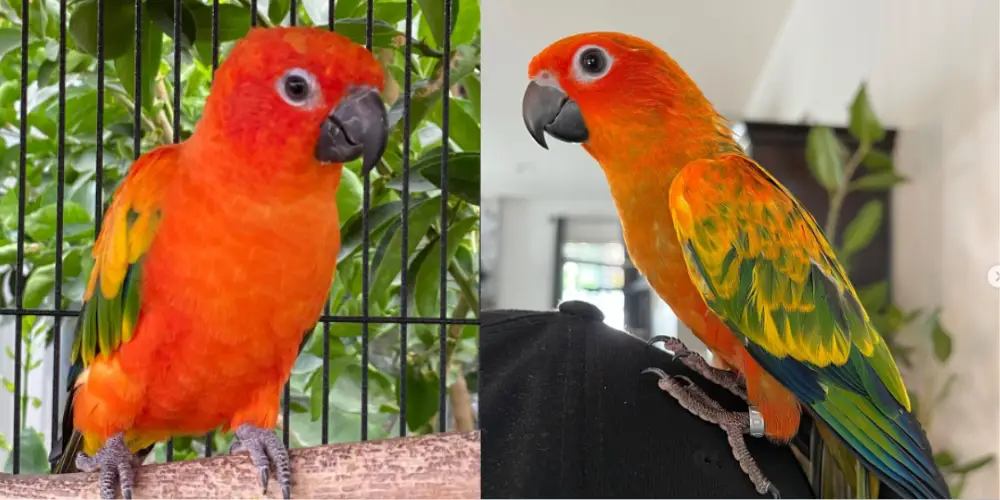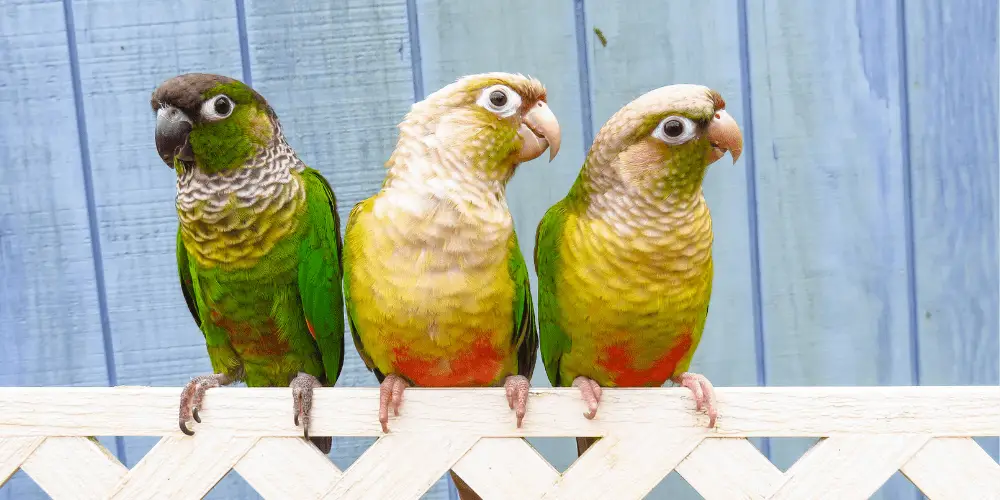The Red Factor Sun Conure is a vibrant and unique bird cherished by enthusiasts for its striking red coloring.
This parrot species is renowned for its unique appearance, making it a popular choice among bird enthusiasts.
But what makes the Red Factor Sun Conure such a fascinating pet?
This guide will explore its care, behavior, health, and buying tips, providing everything you need about this colorful companion.
Key Takeaways
- The Red Factor Sun Conure is known for its vibrant color and unique appearance.
- Its origin and distinct red coloring make it a popular pet bird.
- The Red Factor Sun Conure is a rare and highly coveted mutation among Conures, characterized by its intense red coloring.
- Unlike typical Sun Conures, it has more yellow and orange plumage, and its red hue becomes more vibrant as the bird matures.
- With proper care, Red Factor Sun Conures can live 25 to 35 years in captivity. Lifespan in the wild may vary due to factors like predation and environment.
- Proper diet, nutrition, and housing are essential for the bird’s well-being.
- Creating a stimulating environment is vital for the bird’s happiness.
- Understanding common behaviors helps in training and enhances the relationship with the bird.
- Regular veterinary check-ups, proper nutrition, and awareness of common health concerns are paramount for the bird’s health.
- DIY home care routines and bird-friendly treats can be part of regular care.
- Breeding the Red Factor Sun Conure requires finding a mate, raising chicks, and understanding legal regulations.
- Purchasing considerations include choosing reputable breeders or adoption, assessing health and temperament, and understanding costs.
- The initial purchase price for a Red Factor Sun Conure ranges between $400 and $800, with ongoing costs for care.
- Ethical considerations emphasize responsible breeding and purchasing from reputable sources.
What is a Red Factor Sun Conure?
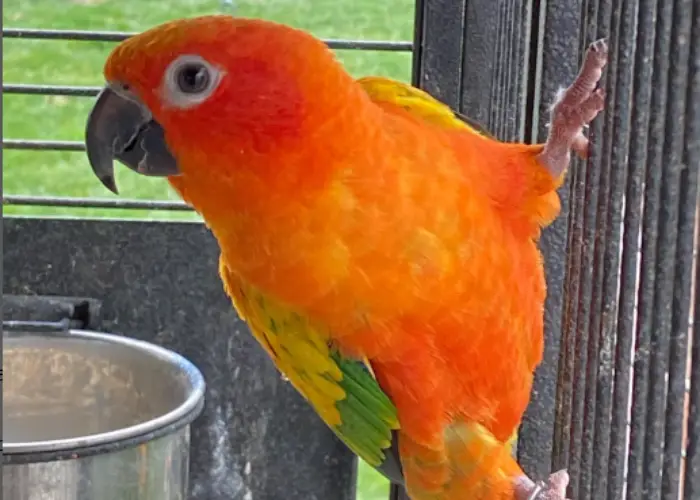
Red Factor Sun Conure, a.k.a. the Red Factor Sun Parakeet (Scientific Name: Aratinga solstitialis), is a popular parrot known for its bright red coloring. It’s a variant of the Sun Conure, selectively bred for its red hue. Among Conures, this red color mutation is rare, making this bird extremely coveted amongst serious collectors.
Definition and Origin
The Red Factor Sun Conure is a specific mutation of the Sun Conure, characterized by its fiery red hue.
When born, this bird is completely red, a unique trait caused by a genetic mutation.
This mutation results from selective breeding, aiming to enhance the red pigmentation in the plumage.
Originating from the South American regions, particularly Brazil, Guyana, and Venezuela, this bird has become a sought-after pet in aviculture.
Appearance
The Red Factor Sun Conure is a sight with its striking red feathers. The deep red coloration extends across the body, with hints of orange and yellow, creating a mesmerizing effect.
A white ring often surrounds their eyes, and their beaks and feet are a contrasting black.
Adult Red Factor Sun Conures typically measure around 12 inches in length and weigh approximately 110 grams.
Unique Traits
Among Conures, this red color mutation is rare, making this bird extremely coveted amongst serious collectors.
As the parrot matures, its red coloring will become more intense and lovely. The Red Factor Sun Conure differs from typical Sun Conures by having more yellow and orange plumage.
Lifespan
In captivity, with proper care, nutrition, and medical attention, these birds can live in the range of 25 to 35 years. Lifespan in the wild might vary due to factors like predation, food availability, and environmental conditions.
Fun Fact
- Name Origin: Did you know that “Conure” refers to the bird’s vocalization? The name derives from the Latin word “to chatter,” reflecting the bird’s talkative nature.
- Color Variation: The intensity of the red color can vary among individual birds, making each Red Factor Sun Conure unique.
- Intelligence: Red Factor Sun Conures are highly intelligent and can learn tricks and even mimic sounds with proper training.
The Red Factor Sun Conure is more than just a beautiful bird; it has a rich history, unique appearance, and engaging personality.
Whether you’re an avid bird lover or just discovering this fascinating species, the Red Factor Sun Conure offers endless opportunities for enjoyment and companionship.
Red Sun Factor Conure Video
Caring for Your Red Factor Sun Conure
Diet and Nutrition
A balanced diet is essential for the well-being of your Red Factor Sun Conure. Here’s an expanded guide to their nutritional needs:
- Recommended Foods: Fresh fruits like apples, berries, and bananas; vegetables such as carrots, broccoli, and spinach; and high-quality bird pellets should form the basis of their diet. Occasional treats like nuts, seeds, and cooked eggs can be offered.
- Toxic Foods to Avoid: Chocolate, avocado, and caffeine are toxic to birds and should be avoided.
- Feeding Schedule: Provide fresh food and water daily, following a consistent schedule. Monitor portion sizes to prevent overeating.
- Importance of a Balanced Diet: A varied diet ensures your bird receives all the necessary vitamins and minerals. Avoid high-fat and sugary foods to prevent obesity and other health issues.
- Water: Fresh, clean water should always be available and changed daily.
Sun Conure Cage and Bird Housing
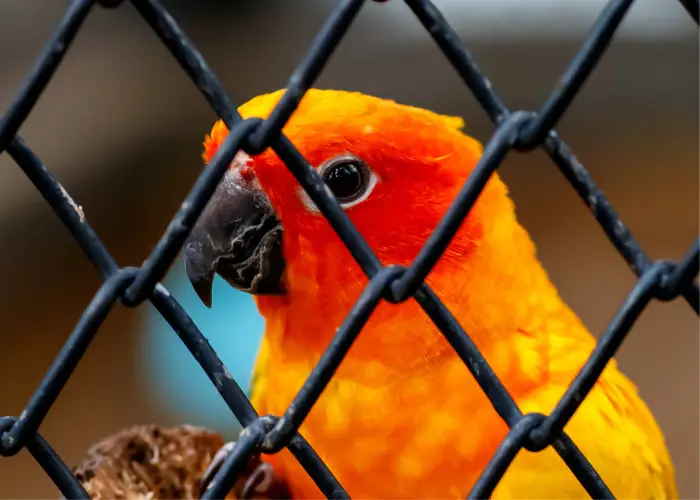
Creating a comfortable and stimulating environment is vital for your bird’s happiness:
- Ideal Cage Size: Choose a spacious cage that should be at least 25” long, 21” wide, and 29” high with ½” wire spacing or 24″ x 24″ wide or larger with bar spacing at about 3/4″ or less. The cage should be spacious enough for the bird to move freely and flex its wings.
- Setup: Include perches of varying diameters, toys, swings, and ladders to entertain your bird. Natural wood perches are preferred, and toys should be bird-safe.
- Location: Place the cage in a well-lit room, away from drafts and direct sunlight. Avoid areas with strong odors or loud noises.
- Cleaning: Regular cleaning of the cage, including the removal of uneaten food and waste, is essential for hygiene.
- Tips for Creating a Stimulating Environment: Rotate toys regularly, provide foraging opportunities, and allow time outside the cage for exercise and social interaction. Interaction with the family is also essential for their mental well-being.
Caring for a Red Factor Sun Conure requires attention to diet, housing, and the overall environment.
Following these guidelines, you can provide a loving home that caters to their unique needs and ensures a happy and healthy bird.
In the next section, we’ll explore the behavior of the Red Factor Sun Conure, offering insights into their everyday behaviors and tips for training and socialization.
Understanding Their Behavior
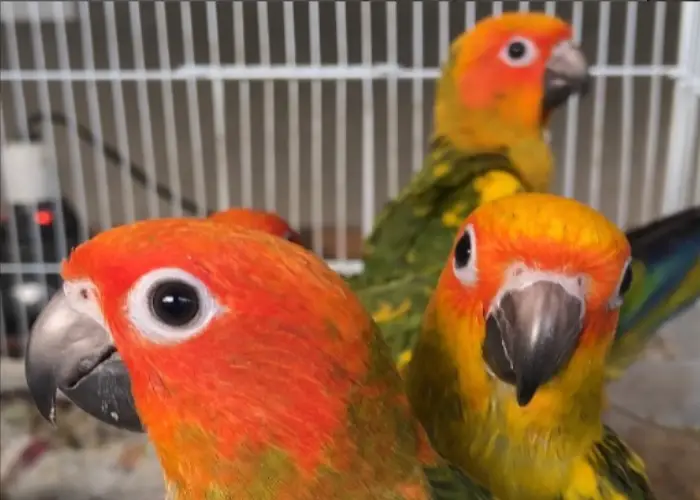
Red Factor Sun Conures are known for their playful and social nature. Understanding their behavior can enhance your relationship with your feathery friend and make training more effective.
Common Behaviors and What They Mean
- Chattering: Conures are talkative birds; their chattering can signify contentment or a call for attention. Listening to their different sounds can help you understand their needs and moods.
- Nipping: Gentle nipping is a form of play, but hard biting may indicate discomfort or fear. Observing the context of the nipping can provide clues to their feelings.
- Fluffing Feathers: This is often a sign of relaxation but can also indicate illness if accompanied by other symptoms. Regular observation helps in early detection of health issues.
- Head Bobbing and Wing Flapping: These behaviors often show excitement and happiness.
- Screaming: Excessive screaming may indicate boredom or distress. Providing toys and attention can alleviate this behavior.
Training and Socialization Tips
- Positive Reinforcement: Reward good behavior with treats and praise. Avoid punishment, as it can lead to fear and aggression.
- Consistency: Keep training sessions short and consistent to reinforce learning. Repeat commands and rewards to solidify behavior.
- Social Interaction: Regular interaction with humans and other birds can help socialize your Conure. Introduce new people and experiences gradually to build confidence.
- Clicker Training: Utilizing a clicker can be an effective way to mark desired behavior and accelerate training.
- Avoiding Bad Habits: Understanding what triggers unwanted behaviors helps in prevention. Redirecting to positive activities can break bad habits.
Personal Story: A Relatable Anecdote from a Bird Owner
“I’ve had my Red Factor Sun Conure, Ruby, for three years. Her playful antics and vibrant personality have brought so much joy to our home.
Understanding her behavior, from her joyful chattering to her playful nipping, has helped us bond and made training a breeze! She’s truly a part of our family.”
Understanding the behavior of your Red Factor Sun Conure is key to a fulfilling relationship.
By recognizing their unique traits, responding to their needs, and employing effective training techniques, you can enjoy a harmonious companionship filled with joy and understanding.
In the following sections, we’ll delve into the health and well-being of the Red Factor Sun Conure, exploring common health concerns and providing tips for prevention and care.
Health and Well-being of Your Red Factor Sun Conure
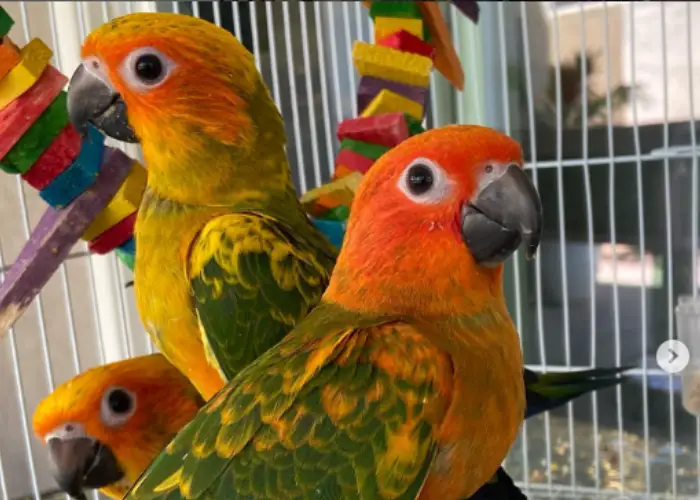
Maintaining the health of your Red Factor Sun Conure is paramount for a long and happy life. Regular check-ups, proper nutrition, and understanding common health concerns can make all the difference.
Common Health Concerns and How to Prevent Them
- Feather Plucking: Often a sign of stress or boredom, providing toys, social interaction, and mental stimulation can prevent this behavior.
- Respiratory Issues: Ensure clean air, proper humidity, and avoid exposure to smoke or strong fumes to prevent respiratory problems.
- Diet-related Problems: A balanced diet prevents obesity, vitamin deficiencies, and liver issues. Avoid high-fat and sugary foods.
- Infections: Regular cleaning and proper hygiene can prevent bacterial and fungal infections.
- Leg and Foot Problems: Providing perches of varying sizes and materials can prevent foot problems.
Importance of Regular Veterinary Check-ups
- Early Detection: Regular check-ups can detect issues before they become serious, saving time and distress.
- Vaccinations and Parasite Control: Your vet can provide necessary vaccinations and treatments to keep your bird healthy and free from mites and other parasites.
- Dietary Guidance: Professional advice on a diet can ensure your bird receives all the necessary nutrients and avoids common nutritional pitfalls.
- Nail and Beak Trimming: Regular grooming by a professional can prevent overgrown nails and beaks, which can cause discomfort.
DIY Tip: Provide a Simple Home Care Routine or Recipe for a Bird-Friendly Treat
- Home Care Routine: Weekly cage cleaning, fresh water, and monitoring behavior can prevent many health issues. Regularly check for signs of illness, such as changes in droppings or behavior.
- Bird-Friendly Treat Recipe: Mix chopped fruits (such as apples and berries), bird seeds, and a little honey, then freeze in small portions for a nutritious treat. These treats can be used for training or as a special reward.
The health and well-being of your Red Factor Sun Conure are vital aspects of pet ownership.
You can enjoy many years of companionship with your vibrant feathered friend by being proactive, attentive to their needs, and working closely with a trusted veterinarian.
In the next section, we’ll explore the breeding and purchasing considerations for those looking to add a Red Factor Sun Conure to their family or even breed them.
Breeding and Purchasing
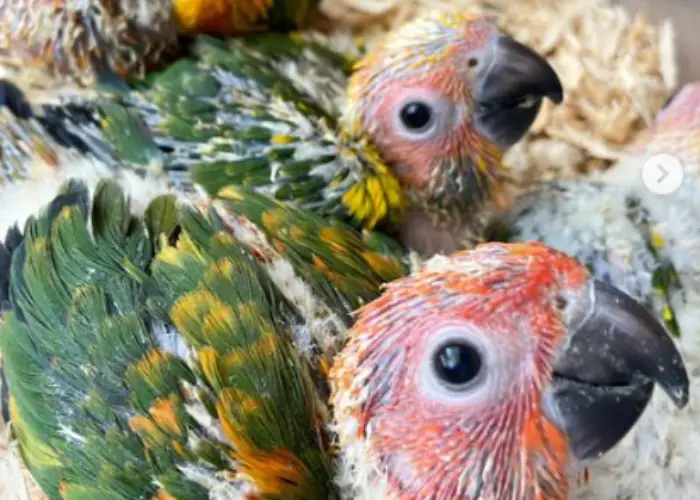
Whether you’re considering breeding your Red Factor Sun Conure or looking to purchase one, understanding the process, costs, and what to look for is essential.
Breeding Considerations and Process
- Finding a Mate: Ensure compatibility by allowing potential mates to interact before breeding. Look for signs of mutual interest and bonding.
- Breeding Environment: Create a comfortable and safe breeding environment with nesting boxes and appropriate materials.
- Raising Chicks: Be prepared for feeding and caring for the chicks. This includes hand-feeding, if necessary, and monitoring their growth and development.
- Legal Considerations: Check local regulations regarding breeding and obtain necessary permits. Some areas may have specific rules or restrictions.
- Ethical Considerations: Breeding should be done responsibly, with consideration for the well-being of the birds and potential homes for the offspring.
Where to Buy and What to Look For
- Reputable Breeders: Purchase from breeders who provide health guarantees and proper care and are willing to answer questions and provide support.
- Adoption Options: Consider adopting from rescue organizations. Adoption can be rewarding to provide a home for a needy bird.
- Health and Temperament: Look for signs of good health, such as bright eyes, clean feathers, and active behavior. Assess the bird’s temperament to ensure it matches your lifestyle and experience level.
- Ask for References: Don’t hesitate to ask for references or reviews from previous buyers if purchasing from a breeder.
Costs (including ongoing)
- Initial Purchase Price: Prices vary, but expect to pay between $400 and $800 for a Red Factor Sun Conure. Age, temperament, and breeder reputation can influence the price.
- Ongoing Costs: Include food, toys, veterinary care, cage maintenance, and potential emergency expenses. Budgeting for ongoing costs ensures a happy and healthy bird.
- Insurance Considerations: Consider pet insurance to help cover unexpected veterinary expenses.
Breeding and purchasing a Red Factor Sun Conure are significant decisions that require careful consideration and planning.
Whether you’re an experienced bird owner or new to aviculture, understanding these aspects will guide you in making informed choices, ensuring a successful and rewarding experience with your vibrant feathered friend.
Conclusion
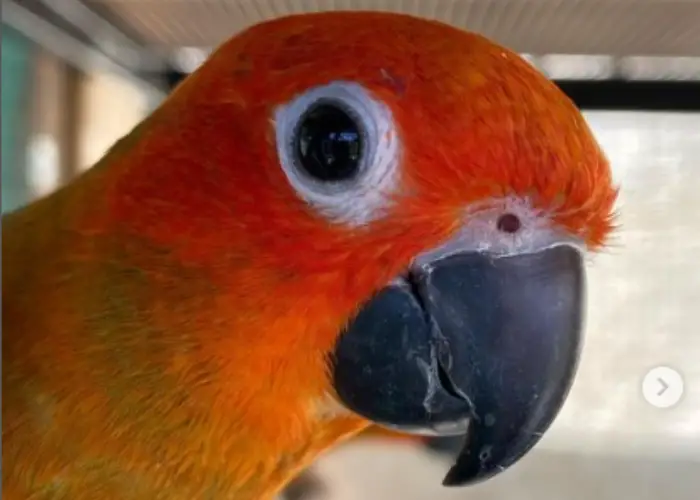
The Red Factor Sun Conure is more than just a vibrant and colorful pet; it’s a companion that brings joy and liveliness to any home.
From understanding its unique traits and behaviors to providing proper care, nutrition, and housing, owning this bird is a rewarding experience.
Whether you’re considering breeding or purchasing a Red Factor Sun Conure, this guide has covered essential aspects to help you make informed decisions.
We invite you to share your experiences and join the community of bird lovers who have found a special friend in the Red Factor Sun Conure.
FAQs
Are red factor sun conures rare?
Red Factor Sun Conures are not extremely rare, but their selective breeding for the red coloration makes them more unique and sought after compared to regular Sun Conures.
Do red factor sun conures talk?
Red Factor Sun Conures can mimic sounds and learn a few words or phrases with consistent training. However, their talking ability is limited compared to some other parrot species.
What is a high red conure?
A high red conure refers to a Sun Conure with an increased amount of red coloring in its plumage. It’s not a specific breed but rather a description of the bird’s appearance, emphasizing the red coloration.
REFERENCES:
- Discover The Hidden Facts About Red Factor Sun Conure Bird. (n.d.). YouTube.https://www.youtube.com/watch?v=Ptxmr4EhS58
- Feathered Companions Aviary. (n.d.). The Red Factor Sun Conure Color Mutation. https://www.featheredcompanionsaviary.com/uploads/1/1/3/9/11394730/red_factor_sun_conure_color_mutation.pdf
- Parrot Forums. (2011, September 25). “High Red” vs “Red Factor” suns. https://www.parrotforums.com/conures/3586-high-red-vs-red-factor-suns.html
- Sun conure. (2023, August 10). In Wikipedia. https://en.wikipedia.org/wiki/Sun_conure
- Image Credits: https://www.instagram.com/olanna_aviary/

